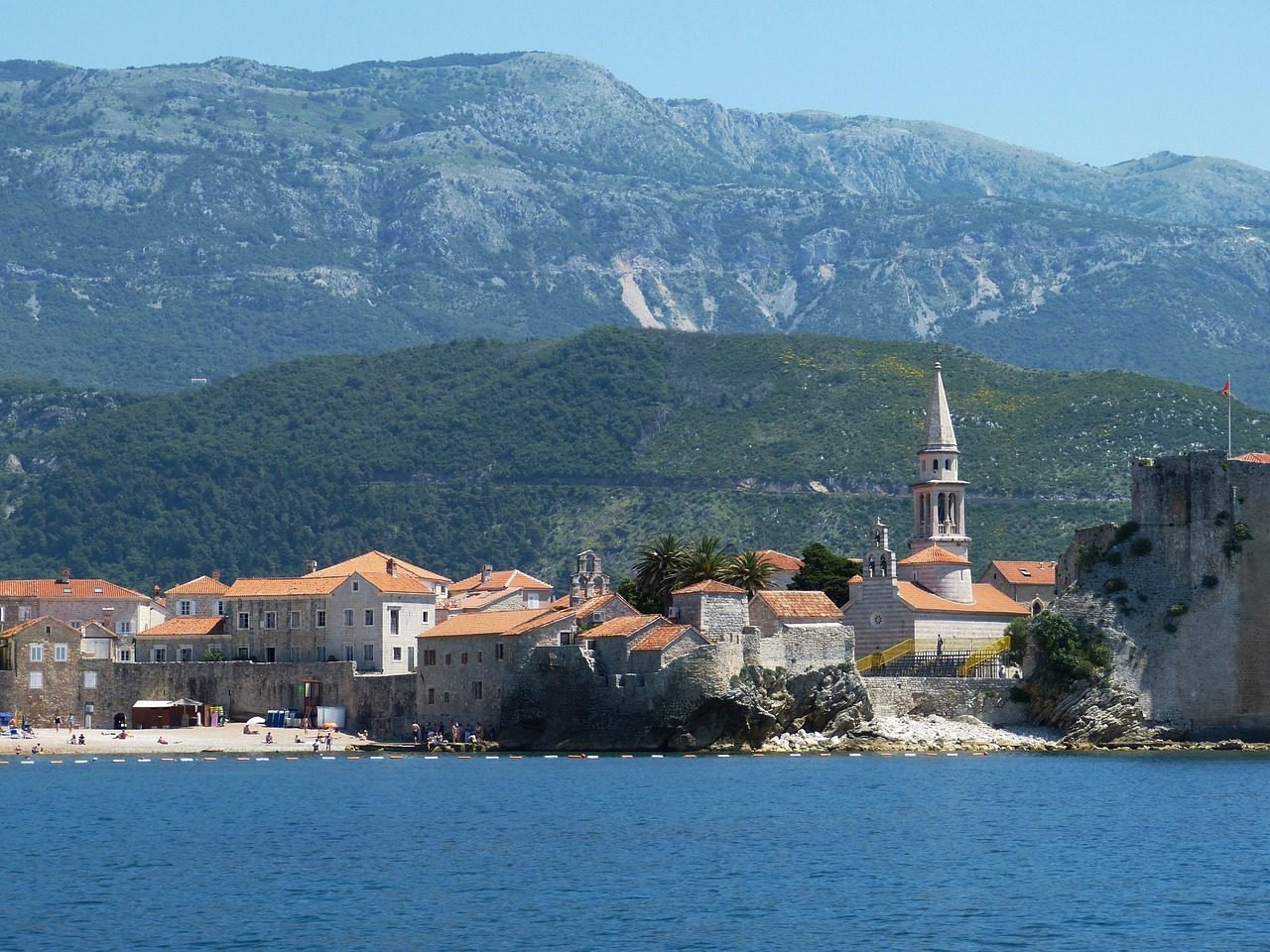Capturing The Best Blue Domes Pictures in Santorini: Complete Guide

Have you ever wondered how to capture those best blue domes pictures in Santorini without ending up with the same photos as everyone else? The blue and white views of this Greek island are well-known. They have been featured in many Instagram feeds, travel brochures, and wallpapers. With some insider knowledge and creative thinking, you can find your unique view in the most photographed places in the world.
Understanding the Iconic Blue Domes of Santorini
Historical Significance of Santorini’s Blue and White Architecture
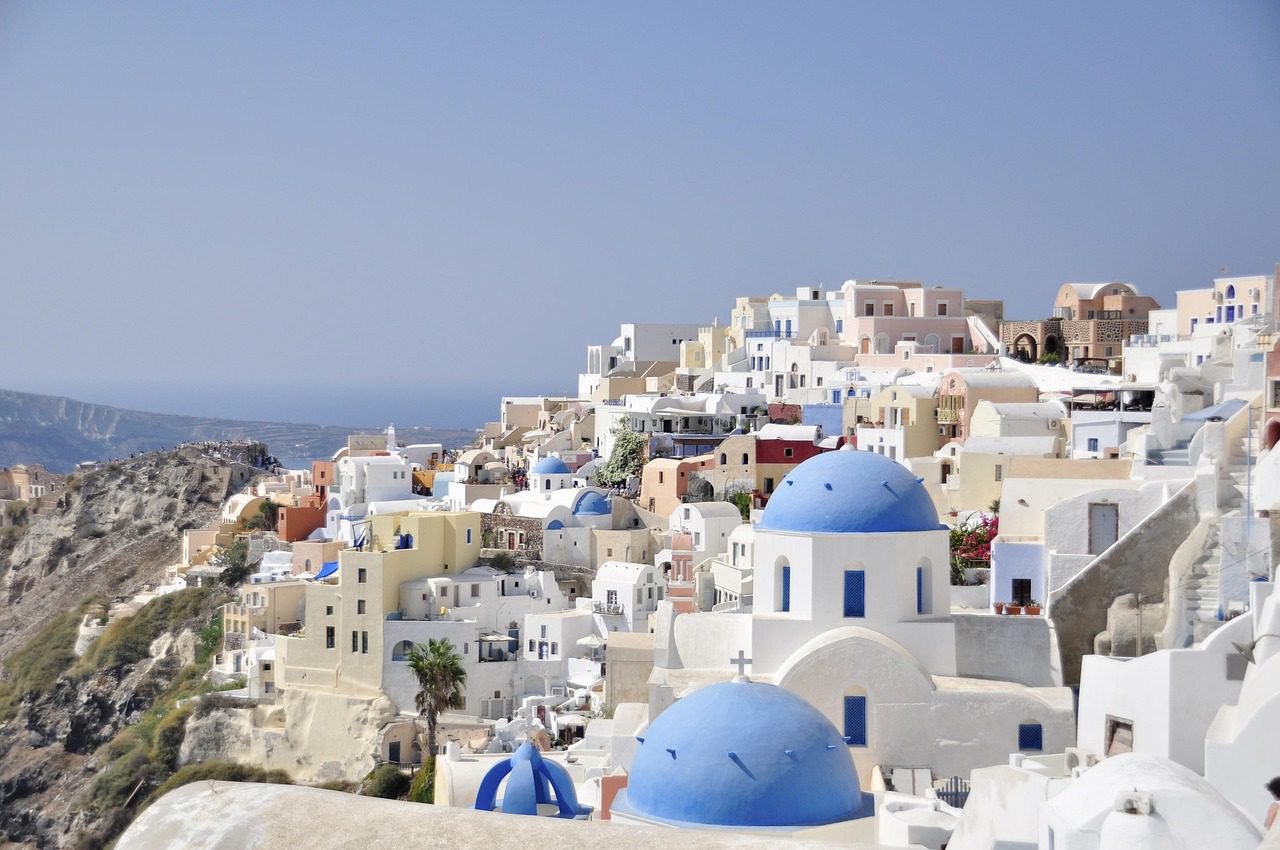
The striking color combination that Santorini is famous for isn’t just for aesthetic appeal—it has deep historical roots.
The whitewashed buildings reflect the harsh Mediterranean sun, keeping interiors cool during scorching summers.
The santorini’s iconic blue and accents, meanwhile, represent the colors of the Greek flag and the endless blue Aegean Sea around the island.
Dating back to the 1970s, the blue-white color scheme became mandatory under Greek law as part of a national identity initiative.
But these colors have been used for centuries before that, with blue pigment derived from a mixture of limestone and copper compounds called loulaki.
Why These Domes Have Captivated Photographers Worldwide
There’s something magical about the visual contrast between the deep cobalt blue domes and the pristine white buildings, all set against the backdrop of the azure sea and sky.
This mesmerizing color palette creates a photographer’s paradise with built-in visual drama.
The curved architecture of the domes adds an organic element to the geometric buildings, creating fascinating shapes that change with the light throughout the day.
The interplay of shadows, the cascading nature of the cliff-side buildings, and the dramatic caldera views all combine to make Santorini’s blue domes irresistible to photographers.
Oia’s Famous Church Compositions
The Classic Three Blue Domes Viewpoint
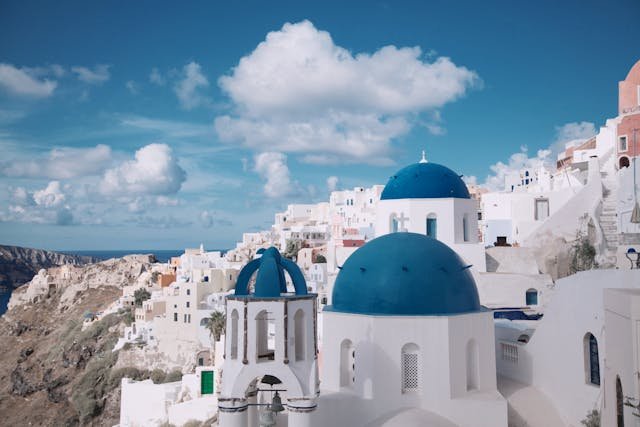
Let’s address the elephant in the room: yes, Oia’s three blue domes of the Anastasi Church are the most photographed spot on the island.
Located in the northern part of Oia village, this iconic viewpoint offers the quintessential Santorini postcard shot.
To find it, head to the main marble pathway in Oia and look for Aspaki Hotel.
Nearby, you’ll find a small jewelry store with steps leading down to a viewing platform. Be prepared—this spot gets extremely crowded, especially during sunset hours.
My advice? Visit at sunrise when most tourists are still sleeping. The morning light bathes the domes in a soft golden glow that’s worth the early wake-up call.
Plus, you’ll have the space to set up your tripod properly without elbowing fellow photographers.
St. Nicholas Church and Its Photographic Potential
While everyone flocks to the three domes, St. Nicholas Church offers equally stunning photographic opportunities with far fewer crowds.
Its bell tower provides a perfect vertical element to balance your compositions.
The church sits closer to the water, allowing you to incorporate more of the sea into your frames.
Try positioning yourself on the pathway below for a perspective that showcases the church against the vastness of the caldera.
Morning vs. Evening Light on Oia’s Blue Domed Churches
Morning light in Oia creates a soft, even illumination on the eastern-facing domes, while evening light dramatically backlights them. Each offers distinct advantages:
Morning photography (6:00-8:00 AM):
- Soft, diffused light with minimal shadows
- Empty streets and viewing platforms
- Cooler temperatures for comfortable shooting
Evening photography (7:00-9:00 PM during summer):
- Rich, warm tones as the sun sets behind you
- Dramatic long shadows adding texture
- Church lights beginning to illuminate as blue hour approaches
Lesser-Known Villages for Authentic Dome Photography
Imerovigli: The Balcony of the Aegean
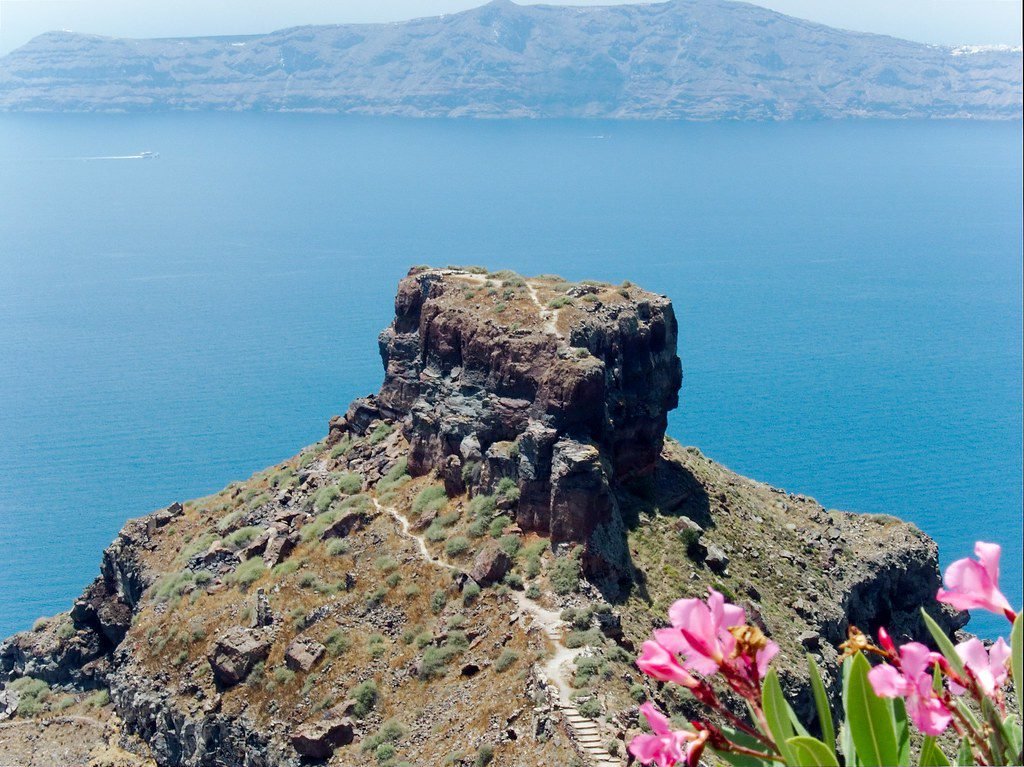
Just a 30-minute walk from Fira, the village of Imerovigli sits at the highest point of the caldera cliff, offering sublime panoramic views and several beautiful blue-domed churches.
The Church of Anastasi provides spectacular photo opportunities without the Oia crowds.
What makes Imerovigli special is the dramatic Skaros Rock formation that can serve as a unique foreground or background element in your dome photographs.
The village’s elevation means you can capture stunning downward perspectives of domes with the sea stretching to the horizon.
For the best shots, explore the pathways behind the Astra Suites and Grace Hotel, where several hidden viewpoints await.
Firostefani: Hidden Architectural Gems
Often overlooked as travelers rush between Fira and Imerovigli, Firostefani houses several charming blue-domed chapels nestled among white buildings.
The Church of Agios Gerasimos offers particularly photogenic angles.
What I love about Firostefani is how the domes here often appear in more authentic settings—next to actual homes rather than luxury hotels.
This gives your photographs a lived-in, genuine quality that’s increasingly rare in heavily touristed areas.
Try wandering the narrow paths early morning when locals are going about their daily routines, adding a human element to your architectural shots.
Pyrgos: Traditional Domes Without the Crowds
Inland and uphill lies the village of pyrgos, a remarkably preserved medieval village with winding paths leading to the monastery of Profitis Ilias at its peak.

Here, blue domes punctuate a sea of white buildings in an amphitheater-like setting.
The elevated position offers unique downward-looking compositions impossible in coastal villages.
On clear days, you can capture blue domes with the entire island and sea as your backdrop—a truly breathtaking perspective.
Visit just before sunset when the low light skims across the textured white walls, creating intricate shadow patterns that add depth to your images.
Mastering Santorini Sunset and Blue Hour Techniques
Golden Hour Preparation and Planning
The magic of golden hour in Santorini transforms ordinary dome scenes into extraordinary photographs. But this fleeting period requires preparation:
- Scout your location at least a day before
- Arrive 45 minutes before actual sunset to secure your position
- Bring a small flashlight for navigating narrow paths after shooting
- Use apps like PhotoPills to track exactly where the sun will set relative to your composition
During summer months, position yourself to capture the warm light hitting the white buildings while keeping the blue domes properly exposed.
A graduated ND filter can help balance the bright sky with the buildings.
Blue Hour Camera Settings for Dome Photography
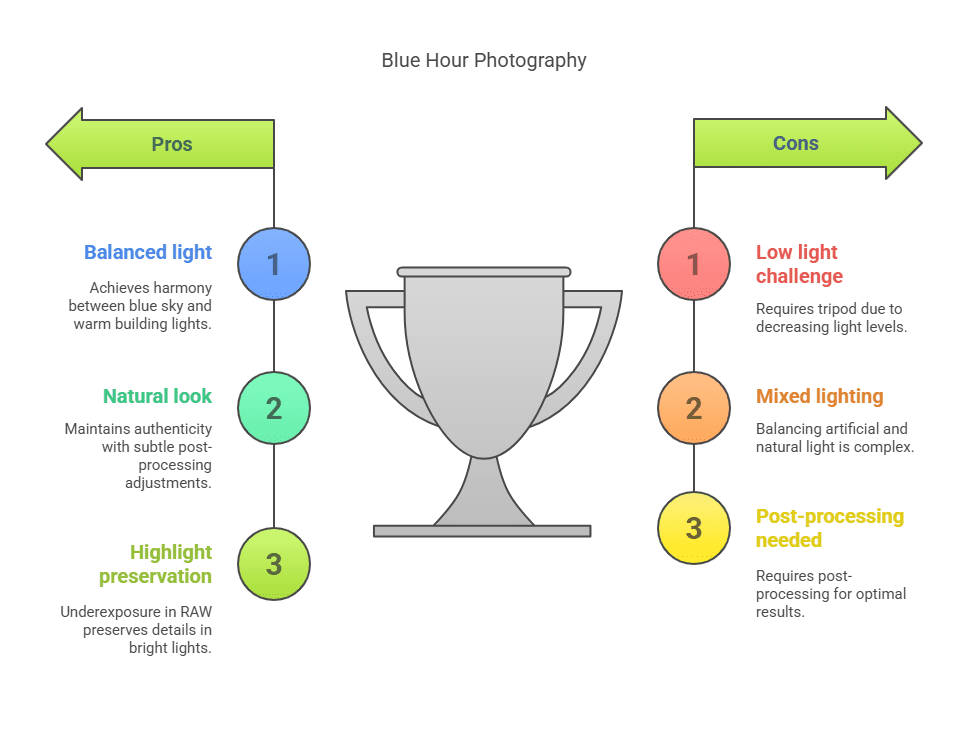
Blue hour—that magical time after sunset when the sky turns a deep blue—creates a perfect color harmony with Santorini’s architecture. For optimal blue hour dome photography:
- Use a tripod as light levels drop
- Set your camera to ISO 100-400
- Choose an aperture between f/8-f/11 for good depth of field
- Start with a shutter speed around 1/15s, adjusting as needed
- Activate 2-second self-timer to minimize vibration
Balancing Artificial and Natural Light
As blue hour progresses, village lights begin illuminating the scene, creating a challenging but rewarding mixed lighting situation. To balance these elements:
- Use white balance around 4000K-5000K to preserve both the blue sky and warm building lights
- Consider taking bracketed exposures (±1 stop) to blend in post-processing
- If shooting RAW, slightly underexpose to preserve highlight details in the lights
A subtle touch of clarity and vibrance in post-processing (rather than heavy saturation) will help maintain a natural look while enhancing the blue-white contrast.
Navigating Santorini’s Narrow Pathways
Essential Gear for Tight Spaces

The charming narrow pathways of Santorini present unique challenges for photographers. When navigating these confined spaces:
- Use a smaller camera bag or sling that won’t knock into walls or people
- Consider a compact tripod with flexible legs (like a Gorillapod) for unusual mounting positions
- Bring a wide-angle lens (16-24mm on full-frame) to capture architecture in tight spots
- Pack only essential lenses—I recommend a wide-angle and a standard zoom (24-70mm)
- Keep lens changes minimal to avoid sensor dust in the often windy conditions
A microfiber cloth is essential, as the combination of sea spray, dust, and occasional donkey traffic can leave lens smudges throughout the day.
Movement Techniques in Crowded Areas
Photographing in Santorini’s popular areas requires patience and strategic movement:
- Study the flow of tour groups—they typically arrive in predictable waves at popular photo spots around the island of Santorini.
- Position yourself at junctions where pathways widen
- Use waiting time to pre-compose your shot mentally
- When a break in crowds appears, move quickly but carefully
- Consider using a slightly longer lens to compress the scene and eliminate tourists from your frame
Remember that early morning (before 8:00 AM) and late evening (after 9:00 PM) offer significantly less crowded conditions, allowing for more deliberate composition and movement.
Ethical Photography: Respecting Private Property
Understanding Local Boundaries
It’s crucial to remember that Santorini isn’t just a photography playground—it’s home to thousands of residents. Many of those picturesque doorways, balconies, and stairways belong to private homes.
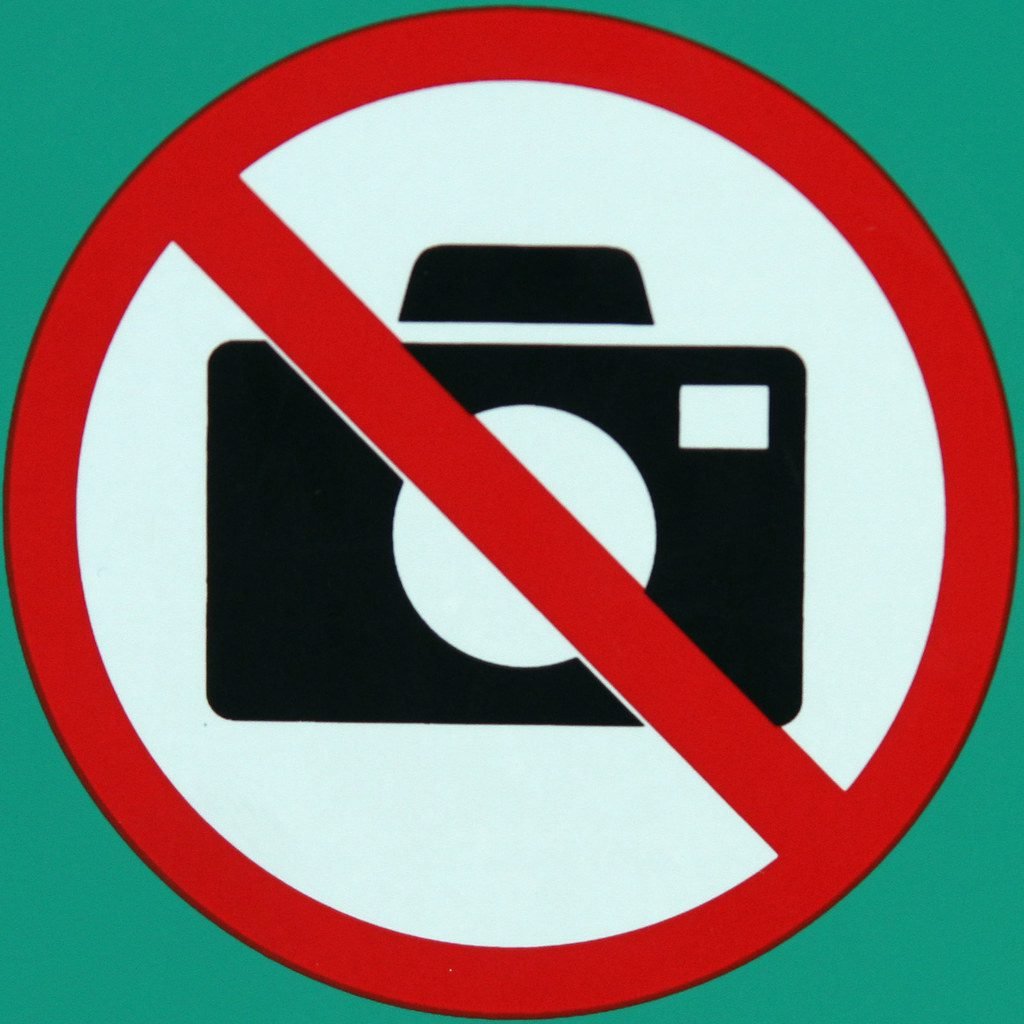
Signs indicating “Private Property” or “No Photography” should be strictly respected.
Even without explicit signage, exercise common sense: if you’re looking directly into someone’s living space or bedroom, that’s not an appropriate photo opportunity.
I’ve found that staying on main pathways and public viewing areas still provides ample photographic opportunities without intruding on local privacy.
Seeking Permission and Proper Etiquette
When in doubt about whether an area is private, always ask. A simple gesture pointing to your camera with a questioning expression works across language barriers.
Many residents have become accustomed to photography enthusiasts seeking the best spots, and some may grant permission for capturing their homes.
If permission is given:
- Keep your visit brief
- Offer to share images via email if requested
- Consider making a small purchase if it’s a business
- Express sincere gratitude
If you’re photographing in a church courtyard, show respect by dressing appropriately (covered shoulders) and maintaining a quiet, reverent demeanor.
Seasonal Guide for Clear Skies and Perfect Shots
Shoulder Season Benefits (April-May, September-October)
While Santorini is beautiful year-round, the shoulder seasons offer photographers significant advantages:
April to May benefits:
- Wildflowers adding pops of color to foregrounds
- Lush greenery before summer drought
- Clearer air quality with excellent visibility
- Comfortable temperatures for lengthy photo sessions
- Fewer tourists obstructing classic viewpoints
September to October benefits:
- Warm sea creating less morning haze
- Stable weather patterns with minimal wind
- Rich sunset colors due to subtle atmospheric dust
- More accommodation options near prime photo locations
- Relaxed pace allowing for creative exploration
During these periods, you’ll find the perfect balance of good weather, reasonable crowds, and photographic opportunities.
Weather Patterns and Photography Planning
Understanding Santorini’s weather patterns helps optimize your shooting schedule:
- Summer (June-August): Expect consistent blue skies but harsh midday light and maximum crowds. The meltemi winds can pick up in afternoons, adding challenges for long exposures or drone photography of the picturesque village of Megalochori.
- Fall (September-November): Gradually increasing chance of dramatic clouds, which add character to blue dome shots. October occasionally brings brief thunderstorms that create spectacular clearing conditions.
- Winter (December-February): Fewer tourists but higher chance of overcast days and periodic rain. Many businesses close, creating a more authentic experience but with limited services.
- Spring (March-May): Increasing reliability of clear skies with occasional puffy clouds that add dimension to your photographs. Wildflowers appear on hillsides, offering foreground interest.
Check weather forecasts for wind conditions—a calm morning is ideal for reflection shots incorporating the sea.
Capturing Mediterranean Light and Sea Views
Incorporating the Aegean Sea in Your Compositions
The relationship between Santorini’s architecture and the surrounding Aegean Sea creates powerful visual narratives. To effectively incorporate sea views:

- Look for natural frames where whitewashed walls or arched doorways reveal glimpses of blue water
- Use stepped buildings to create diagonal leading lines drawing the eye from domes to sea
- Seek elevated positions where domes appear to float above the vast caldera
- Include cruise ships (from a distance) to establish scale and emphasize the island’s dramatic height
The classic S-curve composition works beautifully in Santorini—start with a blue dome in the foreground, let the eye follow the cascade of white buildings, and conclude with the expanse of sea and sky.
Working with Harsh Midday Light
Midday Mediterranean sun creates challenging conditions with extreme contrast between white buildings and dark shadows. To combat this:
- Switch to black and white photography, embracing the graphic qualities of high contrast
- Focus on architectural details and close-ups where you can control the light better
- Look for areas of open shade where light bounces off white walls creating natural fill
- Use a polarizing filter to manage reflections and deepen the blue sky
- Consider shooting HDR brackets to blend exposures (though use subtly to maintain realism)
Alternatively, use harsh midday hours for scouting and planning sunset/sunrise shoots, or enjoy a leisurely Greek lunch while waiting for better light.
Creating Depth with Foreground Elements
Adding depth to your blue dome compositions transforms ordinary shots into compelling visual stories. Effective foreground elements include:
- Cascading bougainvillea flowers adding splashes of pink or purple
- Traditional wooden doors with weathered blue paint
- Curved whitewashed staircases leading the eye to domes
- Bell towers creating vertical framing elements, such as the three bells at the Church of Panagia, enhance the beauty of the island of Santorini.
- Terracotta pots and Greek urns providing cultural context
Try positioning these elements in the lower third of your frame, using wide apertures (f/2.8-f/4) to create subtle depth of field that draws attention to the domes.
Camera Settings for Santorini Dome Photography Success
Exposure Compensation for White Buildings
Santorini’s brilliant white buildings frequently trick camera meters into underexposure. To counter this:
- Start with +2/3 to +1 exposure compensation in evaluative/matrix metering mode
- Check your histogram to ensure you’re capturing white as white (not gray)
- Use highlight warning/zebras to avoid blowing out important details
- Consider spot metering on a mid-toned area (not the white walls or blue sky)
When shooting in challenging midday conditions, bracketing exposures (±1 stop) provides insurance against exposure errors and gives flexibility in post-processing.
Depth of Field Considerations
Choosing the right aperture greatly impacts dome photography:
- For classic wide scenics incorporating multiple domes and distant sea: f/8-f/11
- For emphasizing a single dome against a blurred background: f/2.8-f/4
- For nighttime shots including stars above domes: f/2.8 or wider
Remember that very narrow apertures (beyond f/16) can introduce diffraction, reducing overall sharpness. In most Santorini landscape scenarios, f/8 provides the optimal balance between depth of field and image quality.
Focus stacking—taking multiple shots focused at different distances and blending in post-processing—can be valuable for complex scenes with interesting foreground elements leading to distant domes.
Lens Selection for Various Dome Perspectives
Wide-Angle vs. Telephoto Approaches
Different lenses create dramatically different interpretations of Santorini’s blue domes:
Wide-angle lenses (16-35mm):
- Emphasize the dramatic relationship between architecture and landscape
- Create exaggerated perspective with nearby domes appearing larger
- Include more environmental context and sky
- Work well in tight village pathways
- Challenge: Managing distortion of circular domes
Standard zoom lenses (24-70mm):
- Provide versatile range for most dome photography
- Render proportions more naturally
- Allow quick recomposition without changing position
- Ideal for balancing architecture with human elements
Telephoto lenses (70-200mm):
- Compress layers of villages against the sea
- Isolate individual domes from cluttered surroundings
- Capture details unreachable due to physical constraints
- Create abstract patterns of repeated domes and cubic structures
- Minimize the appearance of tourists by tightly framing the iconic blue domes in Santorini.
My personal approach is to carry a 16-35mm and a 70-200mm, skipping the middle range to force more creative decisions.
When to Use a Polarizing Filter
A polarizing filter is perhaps the most valuable accessory for Santorini photography:
- Deepens blue skies to enhance contrast with white buildings
- Reduces glare from whitewashed surfaces
- Cuts reflections on the sea for clearer water color
- Improves clarity in hazy conditions
- Adds approximately 1.5 stops of light reduction, helpful in bright conditions
Be careful when using ultra-wide lenses with polarizers, as uneven polarization across a wide sky can create unnatural-looking gradients.
Most noticeable benefit comes when shooting at 90° to the sun.
Sample Technical Breakdown of Successful Dome Photos
Analyzing Composition Elements
The most compelling Santorini dome photographs typically incorporate these compositional techniques:
- Rule of thirds placement: Positioning primary domes at intersection points can help highlight the beauty of the blue domes in Santorini.
- Framing: Using arched doorways or bell towers to contain dome views
- Leading lines: Following curved staircases or pathways toward domes
- Color contrast: Maximizing the visual tension between blue and white
- Layering: Creating distinct foreground, middle-ground, and background elements
One particularly effective technique is to use the cubic architecture as a geometric counterpoint to the soft curves of the domes—this contrast creates visual interest beyond just the color relationships.
Color Theory in Blue and White Photography
Understanding color relationships elevates your Santorini photography:
- The complementary blue and orange/yellow (sunset light on white buildings) creates natural visual tension
- Blue domes against blue skies can be differentiated through saturation and brightness adjustments
- White buildings take on subtle color casts throughout the day—pink at dawn, golden at sunset, blue during twilight
- Selective color pops (red geraniums, pink bougainvillea) can provide focal points amid the blue-white palette
In post-processing, subtle split-toning with warm highlights and cool shadows can enhance the distinct Cycladic mood without appearing artificially processed.
Best places to take photos
GPS Coordinates for Prime Shooting Spots
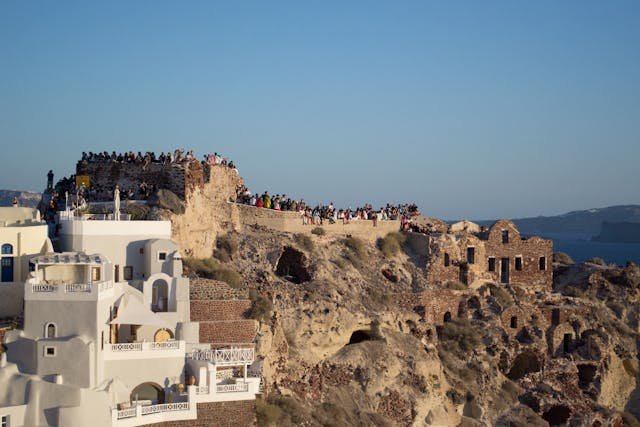
Beyond the famous three domes of Oia, consider these specific coordinates for unique perspectives:
- Oia Castle ruins (36.4615° N, 25.3765° E) – Elevated view of cascading village with multiple domes, including iconic blue domes in Santorini.
- Byzantine Castle Ruins, Oia (36.4611° N, 25.3756° E) – Classic sunset panorama including several domes
- Imerovigli Blue Dome viewpoint (36.4293° N, 25.4317° E) – Less crowded alternative with Skaros Rock backdrop
- Prophet Elias Monastery (36.3933° N, 25.4446° E) – Highest point on island, domes seen from above
- Firostefani Church path (36.4254° N, 25.4284° E) – Intimate dome views with minimal tourist presence
Save these coordinates to your phone before your trip to the island of Santorini, as cellular service can be spotty in some areas.
Alternative Viewpoints for Unique Angles
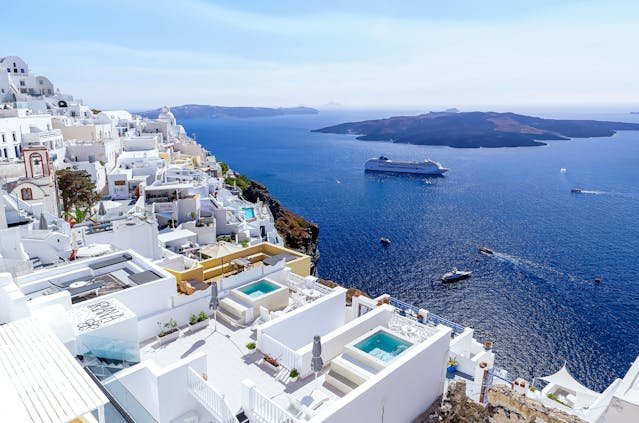
Beyond the well-known spots, consider these alternative approaches:
- Boat tours offering sea-based perspectives of all villages simultaneously
- Early morning walks along the caldera path between Fira and Imerovigli
- The back sides of villages where local life continues uninterrupted by tourism
- Akrotiri Lighthouse area for distant telephoto views of Oia
- Ammoudi Bay looking upward to Oia’s cliffside buildings
One particularly rewarding experience is to rent a room with a private terrace facing the caldera—this provides exclusive morning and evening shooting opportunities from perspectives unavailable to day-trippers.
Seasonal and Time-of-Day Considerations
Monthly Photography Calendar for Santorini
Each month offers distinctive photographic opportunities:
- April: Wildflowers and green hillsides, clearer air, Easter celebrations with candle-lit processions
- May: Perfect balance of good weather, moderate crowds, clear visibility
- June: Long daylight hours, consistent weather, deepest blue seas
- July-August: Peak season for tourists flocking to the best spots in Santorini. Challenging heat and crowds, but dramatic clear skies
- September: Warm seas creating beautiful reflections, stable weather
- October: A great time to explore the best spots for capturing the blue domes in Santorini. Occasional dramatic clouds, harvest activities, golden vegetation
- November: Increasing chance of moody atmospheric conditions, most authentic village life
- Winter months: Quiet villages, potential for dramatic stormy skies, limited services
For most photographers, May and late September offer the ideal combination of photographic conditions and practical considerations.
Sunrise vs. Sunset: Making the Right Choice
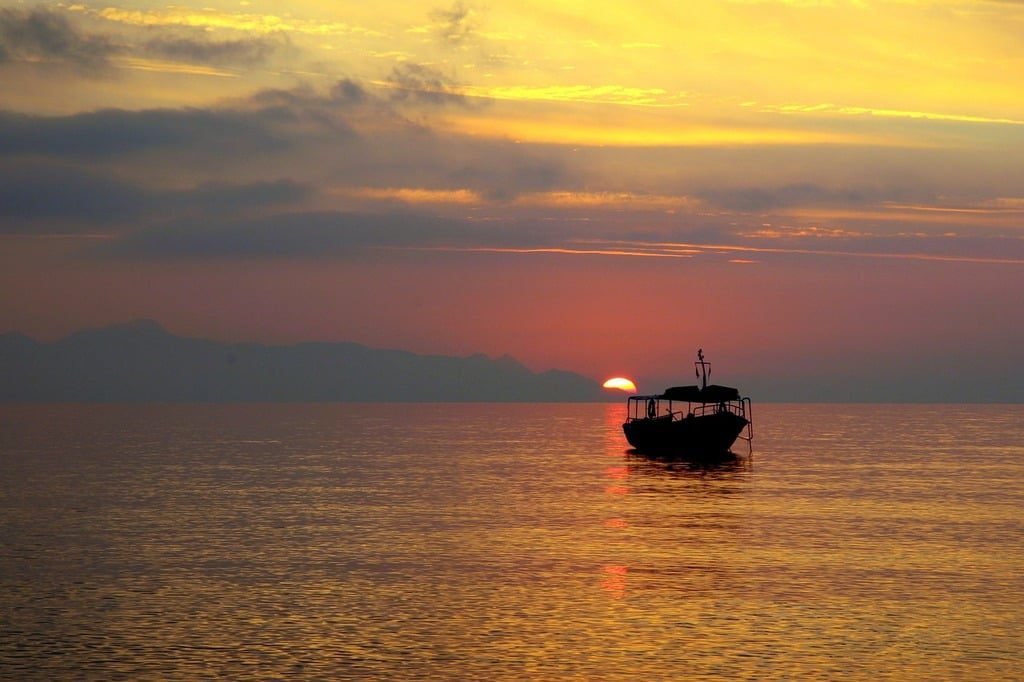
Both golden hours offer spectacular light, but with different advantages:
Sunrise benefits:
- Dramatically fewer people
- Soft, even illumination on eastern-facing domes
- Cooler temperatures for comfortable shooting
- Greater opportunity for solitude and reflection
Sunset benefits:
- Warmer color temperature casting golden light on white buildings
- More activity and life in villages
- Blue hour transitions into village lights
- No need for early wake-up calls
I recommend experiencing both, but if forced to choose one, sunrise provides more peaceful shooting conditions while sunset often delivers more dramatic colors.
Navigating Local Customs and Photography Regulations
Church Photography Etiquette

Churches and chapels require special consideration:
- Many churches welcome photographers outside but restrict indoor photography
- Always remove hats when entering
- Dress modestly covering shoulders (carry a light scarf)
- Never disturb active worship services for a photograph
- Donate a small amount if you spend significant time photographing a particular church
- Some churches request no photography of specific religious icons
The most photogenic churches often have exterior placards explaining specific rules—take a moment to read these before shooting.
Drone Regulations Around Historical Sites
Drone photography regulations in Santorini are strict:
- Legal drone flights require advance permission from the Hellenic Civil Aviation Authority
- No-fly zones include all archaeological sites, crowded villages, and during most daylight hours in summer
- Flying within 50 meters of private residences is prohibited
- Maximum altitude is 120 meters/400 feet above ground level
- Operators must maintain visual line of sight
Given these restrictions, most memorable Santorini drone footage you’ve seen was either captured with special permits or potentially illegally. Consider helicopter tours as a legal alternative for aerial perspectives.
Common Mistakes and How to Avoid Them
Overexposure Problems and Solutions
The number one technical challenge in Santorini photography is properly exposing white buildings without losing detail. Common mistakes include:
- Trusting the camera’s auto exposure completely
- Failing to check highlights in image review
- Not bracketing in challenging light
- Overcompensating with too much HDR in post-processing
Solutions:
- Use the histogram to verify exposure—the right side should show data but not be clipped
- For critical shots, take one frame slightly darker than you think necessary
- Use spot metering on a mid-tone (not the white walls)
- Consider manually blending exposures for a more natural look than automated HDR
Composition Errors in Dome Photography
Even experienced photographers make these common composition mistakes:
- Cluttered backgrounds with distracting elements
- Horizon lines cutting through domes
- Incomplete domes at frame edges
- Including too many subjects without clear focus
- Over-reliance on ultra-wide lenses creating distortion
Take time to scan the edges of your frame before clicking, and consider simplifying your compositions to emphasize fewer, stronger elements rather than trying to include everything.
Conclusion: Creating Your Unique Santorini Portfolio
Santorini’s blue domes present both challenge and opportunity—the challenge of finding fresh perspectives on frequently photographed subjects, and the opportunity to create images that best blue domes pictures in Santorini.
The key to success lies in patience, preparation, and perspective.
By exploring beyond the most famous viewpoints, understanding the interplay of light throughout the day, and respecting both the physical environment and cultural context, you can create photographs that stand apart from standard tourist snapshots.
Remember that technical perfection matters less than emotional impact.
Sometimes the most memorable image isn’t the one with perfect exposure and composition but the one that captures a fleeting moment—morning light breaking through clouds to illuminate a single dome, or a local resident passing beneath an archway.
Let Santorini’s remarkable landscape inspire you, but don’t be constrained by the photos you’ve seen before.
Your unique vision, combined with the practical techniques we’ve explored, will help you create a portfolio that captures not just the iconic blue domes, but your personal experience of this magical Greek island.
Frequently Asked Questions
What is the best time of year to photograph Santorini’s blue domes?
The optimal times are mid-April to early June and mid-September to late October. These shoulder seasons offer excellent light, comfortable temperatures, clearer air, and significantly fewer crowds than summer months, while still providing reliable good weather for photography.
Do I need special permission to photograph the famous blue domes?
Most exterior photography from public pathways requires no special permission. However, some prime viewing spots are now associated with hotels or restaurants that may restrict access to paying customers looking for the best views.
Interior photography of churches often requires explicit permission from caretakers. Always respect “no photography” signs and private property boundaries.
What camera gear is essential for photographing Santorini?
While any camera can capture beautiful images, the most versatile setup includes: a wide-angle lens (16-35mm equivalent) for village scenes, a medium telephoto (70-200mm equivalent) for compressed perspectives and details, a sturdy but lightweight tripod for blue hour, a polarizing filter to manage reflections and enhance skies, and plenty of memory cards and spare batteries.
How can I photograph the three blue domes in Oia without crowds?
Visit at sunrise (around 6:00-6:30 AM in summer) when few tourists are awake. Alternatively, visit during the shoulder season (May or October) when crowds are significantly reduced.
Another approach is to use a telephoto lens from alternative viewpoints to isolate the domes without showing the crowded viewing platforms.
Are there any photography workshops or guides specializing in Santorini’s architecture?
Yes, several professional photographers offer specialized Santorini photography tours and workshops ranging from half-day sessions to week-long intensives.
These typically include access to lesser-known viewpoints, optimal timing advice, and technical guidance.
Booking well in advance is recommended, especially for peak season, as the best guides have limited availability.


